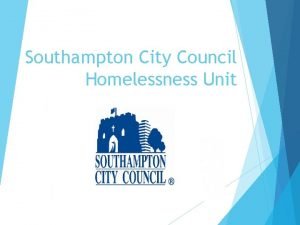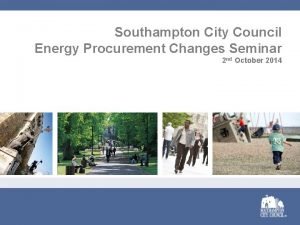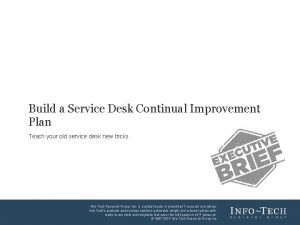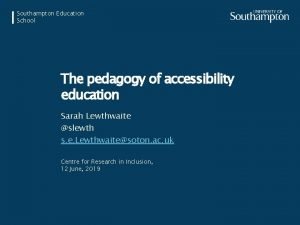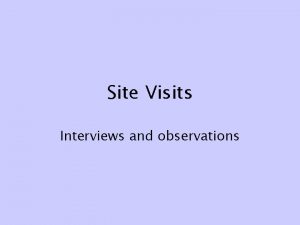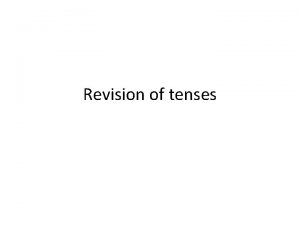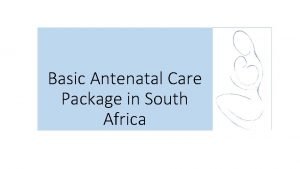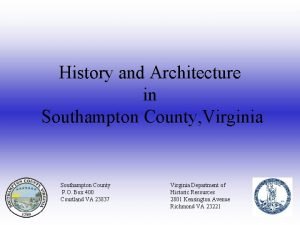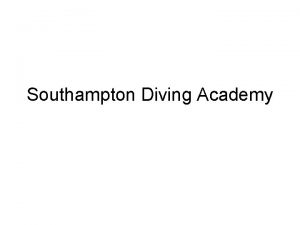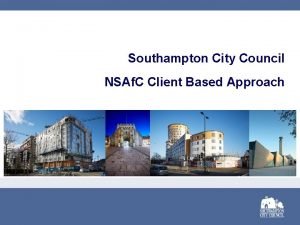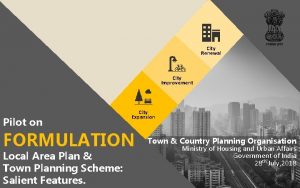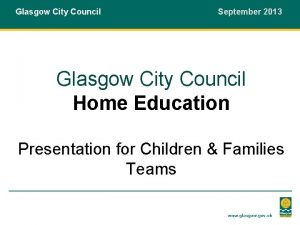Southampton City Council School Improvement Service ANNUAL VISITS








- Slides: 8

Southampton City Council School Improvement Service ANNUAL VISITS – 14. 06. 16

Children and young people have the best start in life Our vision for Southampton schools Families will have access to high quality education across the city. Children will achieve well in safe, exciting centres of learning and get the very best possible start in life. Key principles – we will • act as the champions for children and families • have a collective responsibility with schools for raising standards /improving life chances • take a holistic and evidence based approach to school improvement, based on a multi-disciplinary team approach to school engagement • Be accountable and transparent, with a particular focus on school governance, leadership and management • Show commitment to inclusion and the importance of safeguarding welfare and outcomes for all, especially the most vulnerable • Show commitment to and trust in schools as self-managing and improving institutions • Ensure partnership working with the Teaching School Alliances in order to provide all schools access to high quality professional services • Offer a targeted approach, meaning we target school improvement resources where they are most needed

The Annual Review process 1. The Annual Review process is an opportunity for the local authority to qualityassure the self-evaluation process undertaken by governors and leaders at each school. 2. It enables us to make a judgement on both the current performance and the capacity of each school to sustain and build upon its performance. 3. The Annual Review informs the process of categorisation as to the monitoring, challenge, support and intervention (MCSI) from the local authority deemed appropriate for each school. 4. Annual Review reports will inform the decisions on categories made by the Schools Monitoring Group (SMG) of LA officers and headteacher conference representatives. 5. The categorisation process is reviewed each year by the Schools Monitoring Group (SMG) of LA officers and headteacher conference representatives.

The Annual Review process 1. The Annual Review will place a sharp emphasis upon how accurate and well evidenced each school’s self-evaluation is 2. It will look at how incisively governors and leaders are establishing the right improvement priorities and addressing these through robust improvement plans and sharp reviews of their impact on outcomes 3. The attached officer will seek to corroborate the evidence presented about each facet of school performance 4. The review will look at pupil outcomes, teaching, learning and assessment, pupils’ personal development, including safeguarding, governance, leadership and management 5. Early Years and Sixth Form provision will be studied where relevant

The Annual Review process Pre Visit • The SIO will read the school’s previous Note of Visit, its last Section 5 inspection report and any Section 8 monitoring inspection letters. S/he will also study the school’s website noting compliance. • The SIO will have read the school’s RAISE online report, Inspection Dashboard and, requesting each to be sent by email five working days before the visit, the school’s self-evaluation summary, school improvement plan, and latest assessment information in the school’s usual format + latest attendance / exclusions data. • The SIO will agree the particular purpose of the visit and lines of enquiry and its agenda with the headteacher.

Assessment information • Given the changes to accountability mechanisms, officers will be sensitive to the challenges schools have faced in 2015 -16. • We will not look at any outcomes results in isolation. We will place a particular accent on progress for all pupils and vulnerable groups. • We will take a holistic approach; taking school and visit evidence into account about (a) how all year and pupils groups are doing over time and (b) the extent to which all sources of evidence, such as work scrutiny findings, serve to underpin the schools’ judgements. • We will study each school’s assessment information in the format in which it is routinely collated analysed; it is for leaders to present a concise and telling summary of how well pupils are progressing and standards are rising / sustaining.

The Annual Review process Format for the visit • Invitation for senior leader / Chair to share school’s context and summary judgements • Discussion of assessment information, including attendance / exclusions; a particular emphasis on key subjects / phases, and vulnerable groups – Disadvantaged pupils, SEND, more able and Looked After Children. • How well does lesson evidence, work scrutiny, pupil interview and this information tell the story of progress / attainment for pupils? How well has school done on the outcomes ‘risk indicators’ for the city? • Joint Learning Walk (with senior leaders) to explore the quality of teaching, learning and assessment • Safeguarding checks, including SCR and how well policy is being implemented including discussions with DSL, staff and pupils and document scrutiny • Discussion about leadership, management and separately, about governance, exploring the validity of the school’s self-evaluation and any budget management issues • • Clarify emerging main findings, challenges and agreed actions Indicative category discussion, using revised, wider criteria.

The Annual Review process Post visit • The Officer will give brief summary findings at the end of visit feedback, including an indication of the recommended categorisation decision. • The visit report will be compiled, quality assured and sent to the school typically within seven working days of the visit. • The school will be given two working days to respond on matters of factual accuracy. An appeals process is in place. Such appeals would be directed to the Interim Head of School Effectiveness in the first instance. • The final written report is sent to both the headteacher and the chair of governors, placed on our file and used to inform the Schools Monitoring Group (SMG) decision making processes.
